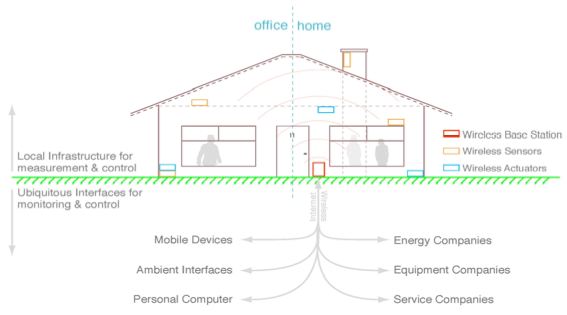Environmental Awareness
One of the most important issues for cities today is Environmental Awareness. The EU's environmental laws help protect against water, air and noise pollution and control risks related to chemicals, biotechnology and nuclear energy. The Environmental Awareness projects contribute to the image (promotion) and to the experience and understanding that people have of pollution and energy usage that is not necessarily self-evident in their cities and homes, and also how their actions as idividuals can impact upon their immediate environment.
Our aim is to enable local inhabitants to interact with technologies that inform and disseminate information on their environment, as well as integrating these interactive technologies into existing urban and home space environments and activities.
To do so we look at the usefulness of:
- Public social experiments where the public have access to monitoring devices
- Public access to pervasive computing that supports sustainability-related behavioral changes
- Integration of interactive environmental awareness demonstrations as mobile, public display and pervasive computing environments
- Mobility using technologies that map how groups and individuals move around the city and how that then impacts upon the environment
- Public Display of information that can inform and make aware city dwellers for their environment and widen participants’ perception and understanding of environmental issues
- Pervasive Computing for supporting awareness of the impact of mobility choices within the city
- Pervasive Computing for supporting awareness of the impact of energy choices within the home
We implement user studies examining how pervasive technologies mediate, redefine, or otherwise influence sustainable behaviors.
 |
 |
|
| MapLens: a using a camera phone as a magic lens on a map to visualise environmental awareness cues in a pervasive game | Ubiquitous sensing in Households for Energy Awareness: turning energy consumers into Active players in the BeAware project. |
Research questions
The track centers on placing awareness of the environment--and increasing for the individual awarenesss of their own impact on their immediate environment--as the central focus for all applications, developments and projects regardless of the techologies being implemented. Through analyses of behaviour and social factors, the track aims to contribute to theories in enhancing take-up of awareness technologies. The intended contribution of track will be two-fold. First, the track will identify new problems and opportunities for environmental awareness applications. Second, the track will produce concepts, models, tools, methods, and theories for succesful implementation and take-up of these solutions. Our methods include evaluation and analysis of pervasive computing technologies using home and game environments, echoing real-use tasks, to include elements of social interaction—cooperation, competition and connection—to engineer more "natural" ubiquitous technology solutions.
Projects
The track is advanced in several including BeAware (Ubicom to turn consumers in active players in energy conservation), IPCity (Interaction and Presence in Urban Environments), and Hydrosys (onsite visualisation for water monitoring).
Contact
Contact : for new projects uix-info (at) hiit.fi, Giulio Jacucci for BeAware. Ann Morrison, for IPCIty MapLens and CityWall, Antti Nurminen for Hydrosys. firstname.lastname(a)hiit.fi
Publications
Morrison, A., Jacucci, G., Peltonen, P., Juustila, A., & Reitmayr, G (2008). Submitted. Using locative games to evaluate hybrid technology. British HCI : Location Aware Games Workshop.
Last updated on 9 Dec 2008 by WWW administrator - Page created on 3 Apr 2008 by Teemu Mäntylä